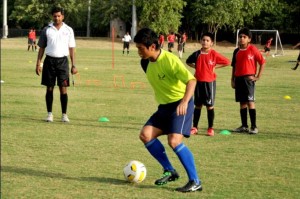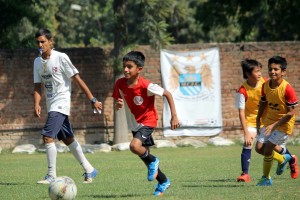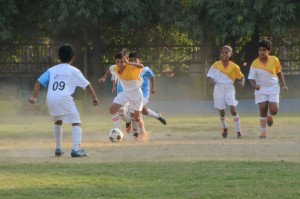 GFI had the opportunity to speak with Stevie Grieve, Head of Coaching & Education at Bhaichung Bhutia Football Schools (BBFS) and Technical Director at Garhwal FC recently. During the conversation, Stevie shared his views on his journey into football coaching, his assessment of grassroots football in India and what BBFS are doing to positively impact Indian football. This is what he had to say…
GFI had the opportunity to speak with Stevie Grieve, Head of Coaching & Education at Bhaichung Bhutia Football Schools (BBFS) and Technical Director at Garhwal FC recently. During the conversation, Stevie shared his views on his journey into football coaching, his assessment of grassroots football in India and what BBFS are doing to positively impact Indian football. This is what he had to say…
GFI: What was the motivation behind getting into coaching?
Stevie: Initially when I was younger, it actually came about when I was playing futsal one night. I was teaching a kid how to do a skill, and then after a little while, the kid could do the skill. I think it was an elastico. And then from that, somebody asked me if I would be interested in coaching as a job. I was only 15 at the time, so when I turned 16, I went to the local community centre and became a coach and, over time, I decided that I would like to make it my career. It wasn’t something that was intentional; it was just something that kind of happened one evening and then I made it my life goal to do something.
GFI: You’ve coached in a few countries – in Scotland, Switzerland, the United States, and now you’re here. What do you see different in India? Are there any different challenges you face here while coaching football?
Stevie: Yeah, if you take India it seems like Europe, it’s like having 24 different countries and different cultures all within a single country. For example, I’m in Mumbai right now, which is vastly different from Delhi in very many ways. In terms of basic infrastructure, because most of India is still a third world country, logistics often become an issue. Finding a place to train, managing the heat and ensuring that the quality of the grounds are good – these things make it more of a challenge than what it would be in Switzerland, or in Scotland or America. Facilities are vastly different, so from a facilities point of view obviously, India is far, far behind most countries.
But, similarly, because of the lack of infrastructure for things, for example in Scotland, you’ve got a small country with 5 million people, and every village will have a football team, or a football facility, like a 7 a side pitch and two goals, and everybody plays it. Whereas in India, you’re still asking kids to travel an hour to go halfway across the city to find a training pitch.
You also have to take into consideration the culture of a country. If you take into consideration the traditional football power of the country, like Scotland used to be one of the best countries in the world in the ’50s, ’60s, ’70s. We had a lot of good players, some among the world’s best, so from that, everybody’s looking for the next best player from Scotland from the next generation to get us back to the World Cup.
If you take Switzerland, it’s a fully developed country, one of the richest in the world, and people immigrate to there from poorer countries such as Albania, the old Yugoslavian nations or Portugal, which are where many of the national team come from; Xhaka, Shaqiri, Behrami, Dzemaili, Benaglio, Drmic, Seferovic, Inler, there’s so many. So the immigration factor is able to assist in the nations youth development as they will play people from other countries with slightly different cultures to the locals, which gives them a slightly more diverse playing base. I guess Americans are somewhat quite similar in that sense. There are immigrants from all over the world, particularly south America or the Caribbean in the US, so the playing culture can be mixed depending on if you live in a Hispanic area or an Italian area etc. I found games are very physical from a young age as they come from a multi-sport background.
In India, you don’t have a multi-sport background. You have cricket, or hockey at most. In terms of the physical ability of a young player, you’ll find American kids are probably more physically capable of controlling their body than an Indian kid. It’s the same in Scotland or Switzerland. That’s because the schools introduce many sports which help physical literacy, which is good for LTPD (Long Term Player Development) and injury prevention. There are many differences, but if somebody was able to come in and change how the schools work and how PE is structured in Indian primary schools, I think it would make a massive difference in terms of the base level of coordination you get from the kids, and then as a result, the football program will become better. Because coaches in clubs only have 3 hours a week or 4.5 hours a week if you’re lucky. So most of the work is done outside of a football ground. So there have been different challenges in the different countries I’ve worked in.
GFI: Do you see grassroots football in India moving in the right direction? Where do you think it is right now? Do you see it going to a good place?
Stevie: From my only experience, just the Bhaichung Bhutia Football Schools (BBFS), we’re growing and we’re getting in a more professional development system for kids in the country. We’re doing everything that we can to produce the best players, and that means finding kids who have less, and are in a situation where they will never be able to afford anything, and we find them – then we provide them travel, provide them opportunities to play, take care of their health, take them out for exposure trips to Europe. They’re in a situation where they would never ever be able to do it on their own. So I think from that point of view, the situation is gradually getting better because of organisations like BBFS and the Indian Football Foundation, which is a charity, who are trying to do the right thing for the kids. And honestly, the talent does come from the poor areas. The talented kids who are also good at school may not always go on to become footballers, until they don’t have to worry about becoming architects, or engineers or doctors or any of these traditional professions.
You also have more people coming to India to help have more kids playing the game, which then increases the size of the talent pool, and then you have certain I-League clubs who are trying to develop academies, which again is a positive sign. And then there are the ISL clubs which are making small investments, nowhere near as much as what it should be, but small investments. The Kerala Blasters are among the few ISL clubs that have got a very good youth program going on just now. So there are things going on in the country, which means to me that things are going in the right direction, although it could do with a lot more help.
GFI: You’ve been with BBFS for about 2 years now. How do you think football as a sport in general is developing in India at a more general level beyond grassroots?
Stevie: I think it’s changing for the better. I think modern Indian parents and modern Indian kids don’t want to spend 8 hours standing on a burning hot cricket field waiting for the ball to come at them every 45 minutes. They think it’s boring. And I especially think Indian society has changed, so I think in 10-15 years, because football’s a more active and engaging game for kids, and because the time and effort spent, and the time spent away from family is much lower, I believe football will be ahead of cricket in terms of popularity.
GFI: Since you’re on the ground at BBFS, do you see more children taking to football than before?
Stevie: Yeah, definitely! When I arrived about two and a half years ago, we had about 600 kids, I think. And now we’ve got 1800. Mainly because the retention rate got higher, because the quality of sessions got better, because we’ve invested a lot of time into coach education and development. With our 12-year curriculum and 7-stage coach education program which is for 7-13 and 13-19 (7v7 / 11v11 coaching) we do 3-4 workshops on the field every week with the FT staff and dev squad coaches to ensure they are getting the best coach education possible.
We also do workshops on theoretical aspects in the classroom a couple of days a week. I would say because of the work we put into coach education, we’ve retained more kids, and because there are more kids and the children are spending more time with us, they are improving more and making the gap between the worst and best kids smaller, they better they all get, coaches included!
We’re educating at least double the amount of coaches since I joined, and now we have several Indian coaches working as mentors, so I think it’s made a massive improvement and a massive influence on Indian grassroots football over the past two and a half years. We’re (BBFS) planning to play in the AIFF U15 Youth League as well. It will be tough, but we like a challenge.
GFI: That’s great to hear! How important do you think football, or let’s say sport in general, is for children?
Stevie: I think sport teaches kids how to be determined, to understand how to win, how to lose, how to overcome adversity, and to become better people in society because you have to interact with more people and I think if sport wasn’t available for kids, I think they’re understanding of how to be good people would be poor, so I think sport is a massive thing.
GFI: Do you think there is an ideal age for children to start playing football?
Stevie: Yes, 2. 2 years old. The reason being that between 2 and 5, the brain sensor capacity, and the muscular capacity to understand how to touch and feel the ball, and to perceive depth and understand speed, time, overall motor skills, is at its maximum. Between 2 and 5 is the most absorbent time for a kid to start doing something football-related. Whether it’s just messing about in a garden, or actually going to a very, very basic football practice where he just runs to a football and kicks it. But definitely, 5 years old is a very important age, because if you stick with it for 2 years, between 5 and 7, you’ll probably stick with it for life. If someone starts at 7, you’ve lost 3 years of development time. If you start at 13, which is normal in India, you’re already passed the main stage, the Foundation Phase, of development.
GFI: Now that the number of football tournaments and leagues are increasing in India, do you see competitive matches as being crucial to the way children are taught the sport and the things they learn from the sport?
Stevie: I think this is a cultural thing. I think in certain countries where it’s needed. Spain needs it, it’s the same in Switzerland and USA. Scotland, I think so too, but that would mean more people playing in a more developmental style for it to be as effective as it could be. But in India, I think the mentality is different. A lot of people here are out for success for themselves and not to help the kids, and you find that any competitive league. For example, we play in the Delhi Youth League, and every week we play against some team who have an Under-13 squad with a 15-year-old, or who are playing in the Under-11s where some boys or girls are 13 or 14 years old. And I think because the leagues are competitive, you’re going to have the age fraud thing.
Coaches are going to say, “Oh you’re no longer 15, you’re going to be 13 so we can win this.” And the kid goes, okay fine, the coach has told me, I’ll just do what the coach says. It’s not because the kid wants to do it, it’s the coaches who want them to do it. If you took away the thing about trophies, would age fraud stop? Maybe. I think that it would. So competition, in terms of playing against the best players you can play against is very, very important, but because of the mentality of some of the people in India, it becomes counterproductive.
So, you’re going to have problems in every place in the world, but what I found in India is that competitive leagues, and competitive things with a trophy – something that you can brag to your friends about – you find that the adults make it a bit of a side-step than it being for the kids, just so that they can say that they won.
GFI: So you’re saying here it’s sort of takes away from the fact that they’re playing a sport, learning & developing, and instead becomes more about winning something?
Stevie: Exactly, I mean, winning seems to be a bad word to use in terms of development. I think it’s very important that kids learn how to win and how to lose, but also to play the game properly. What you find, is that especially in Delhi, you’ve got groups of people, and winning is all they have in their life, and they use the kids as a tool for that. And you’ll find that there’s maybe 3 or 4 kids in a game who will facilitate winning through cheating. Now what does that teach the kids? It teaches the kids that cheating is a way to win, which affects them in the choices they make later in life, so it depends on the area and how you can control it.
GFI: Hmm, so clearly something that needs attention and education from a coach perspective. Let’s talk more about BBFS where there are a lot of good youth coming through. What are the qualities that you look for when identifying the better footballers? Possibly kids who could go on to make it at a high level in the game.
Stevie: Ideally, the first thing I always look for is the body coordination. You have kids who are in control of their body, and you have kids who are not in control of their body. What I mean is that you can see that they take swings at things and miss. Even though they might be good players, the coordination is not completely there, and then we get kids who are good players who are in control of their bodies. Potentially, they can go further because they have more control of the space around them, more control of the ball and control over the outcome of what they’re going to do. So the first thing I always look for is if they have good coordination.
The second aspect I always look for is, are they good technically. Like I said before, if a kid doesn’t have good coordination, but he’s good technically we’re always going to look out and see if we can help his coordination. If a kid’s got good coordination and he’s good technically, then we look for what is the position of spatial awareness on the field. Does does he understand when to run into space and when to stay in space from a technical point of view than a tactical point of view? Does he know which of the three choices is the best for that moment?
Then the last thing we look at is the athletic point of view. So you’ll get some kids who have great control over body, great control of the ball, great control of space and awareness of space in the decisions that they make, but they can’t run because they’re fat, or because they’re malnourished, which is common in India. I think this is a major area that we need to improve on, the athletic aspect. Because I think that’s the bit where we fall behind here, which is partly aided by the school system.
So, if you put the 4 things together – coordination, technique, spatial awareness decision-making and athleticism – you can put them in a state of 1, 2, 3, 4, but sometimes it doesn’t work in that order. You have to put the four qualities together and find out what it is exactly that you want.But with kids it’s possible, if you have a kid that’s not got good coordination, it’s going to be a struggle, but if he’s good with the ball already and is a good athlete and good decision maker, but his coordination is a bit funny, we can try and fix that. The four things have to be put together, but are not always in that exact order every time.
GFI: Very interesting. What is BBFS’ long-term goal for the future?
Stevie: We’re going to produce the best players in the country. There’s no doubt. We’re going to do it. Whether they come from Delhi or Jammu or Chandigarh or Mumbai or Assam or Manipur or Chennai or Kolkata or wherever, we’re going to produce the best players in the country. Not just that, we’re going to produce the best coaches in the country too. Basically, long term BBFS’ vision is to be an environment where coaches come to improve themselves, to then go on and have a long career in football at the professional or grassroots level and we’re going to produce an environment for the best kids in the country. I wrote the vision, that’s why I know!
GFI: According to you, what can be done in India to make football more accessible to the youth?
Stevie: The government has to do something to improve infrastructure in terms of facilities, but also accessibility is important. Also, shopping malls and new residentIal areas need to build sports facilities in the complex or on the roof. All facilities should have metro stations and bus stops next to them. Then people will be able to get to them with less hassle than currently.
GFI: Could you give us some suggestions that coaches, soccer schools and academies might use to improve grassroots football in India?
Stevie: Have a clear vision for what it is you want your coaches to be able to do, and then what a good coaching session should look like – how will you achieve your learning objectives? From that you should be able to put something together where you know that the kids are coming in and getting the highest quality service that they’ll get. And then from there you’ll be able to produce better quality players where kids enjoy the game a lot more.
GFI: Right, Stevie. That’s plenty for now, thank you for your time and we will definitely catch up again soon!
Stevie: You’re welcome.
So that was what Stevie had to say about coaching and football in India. If you’d like to stay in touch with him, give Stevie a follow on Twitter or you can catch him on TEN Sports where he is a Studio Football Analyst for UEFA Champions League games.






March 10, 2016 at 8:34 pm
Excellent and Insightful! Football in India needs a lot more coverage than it currently gets.